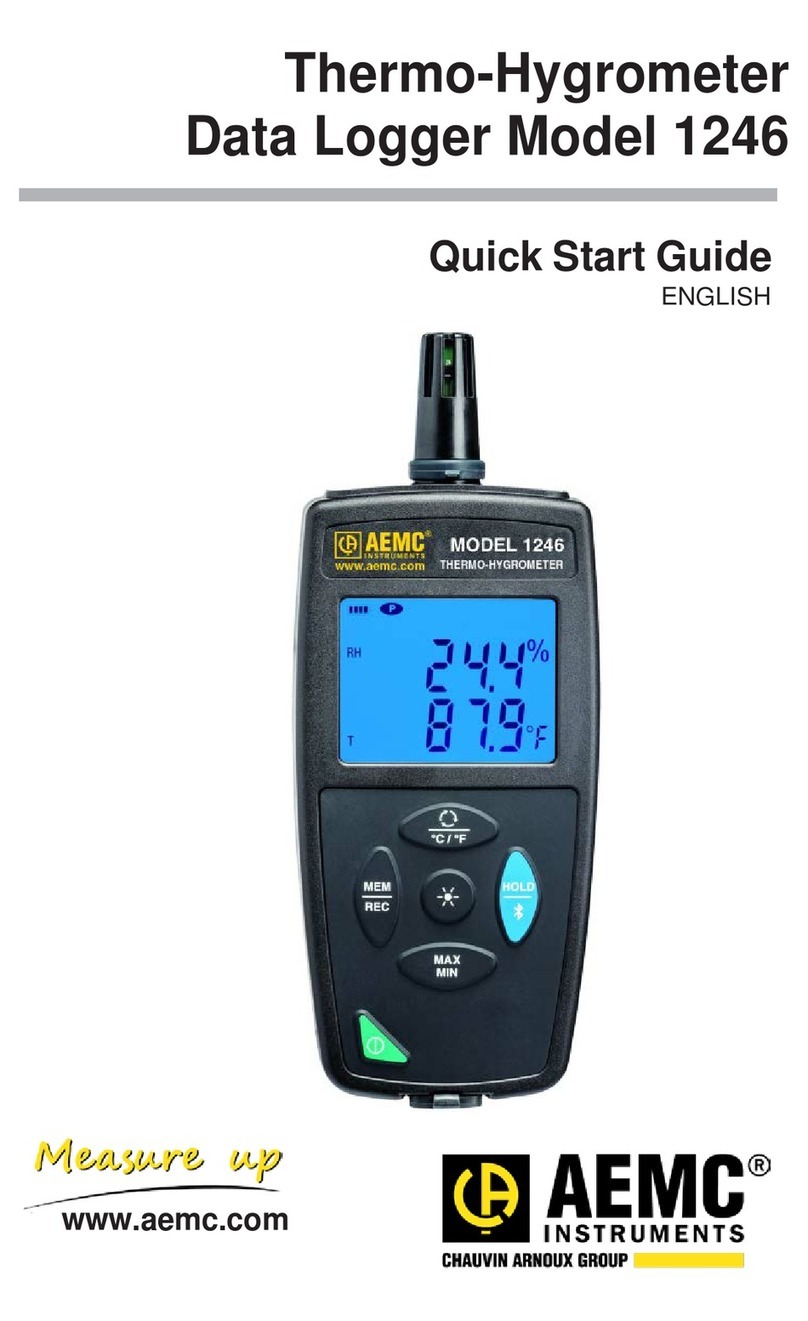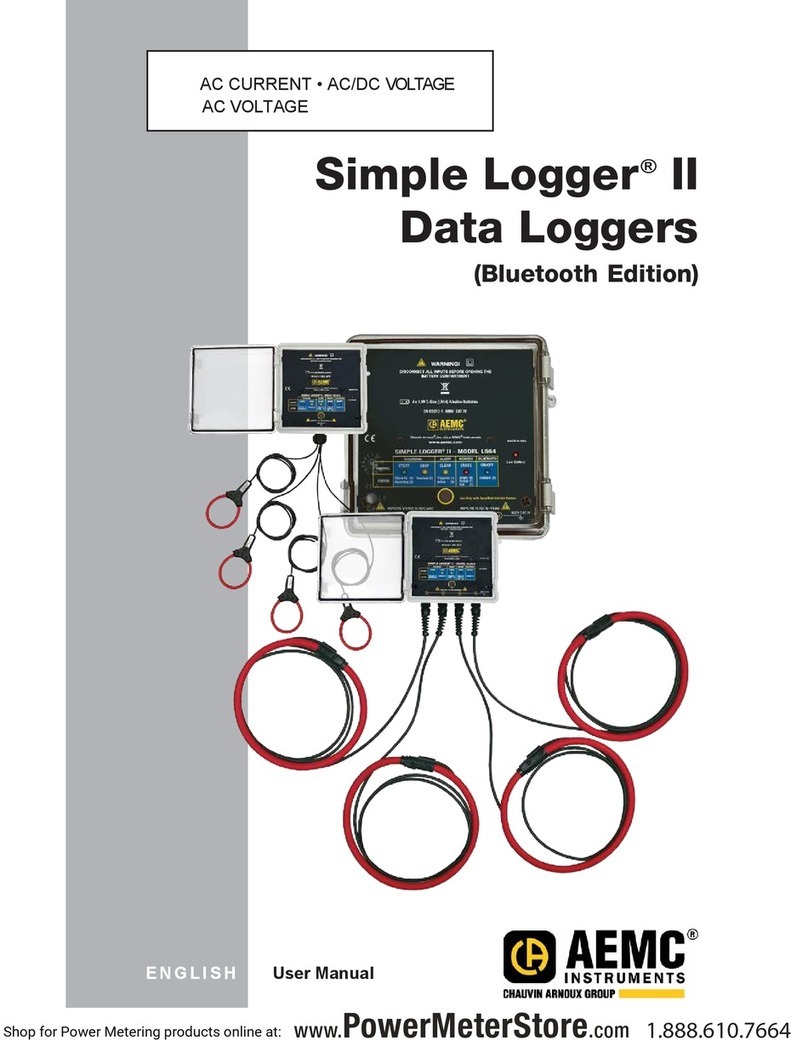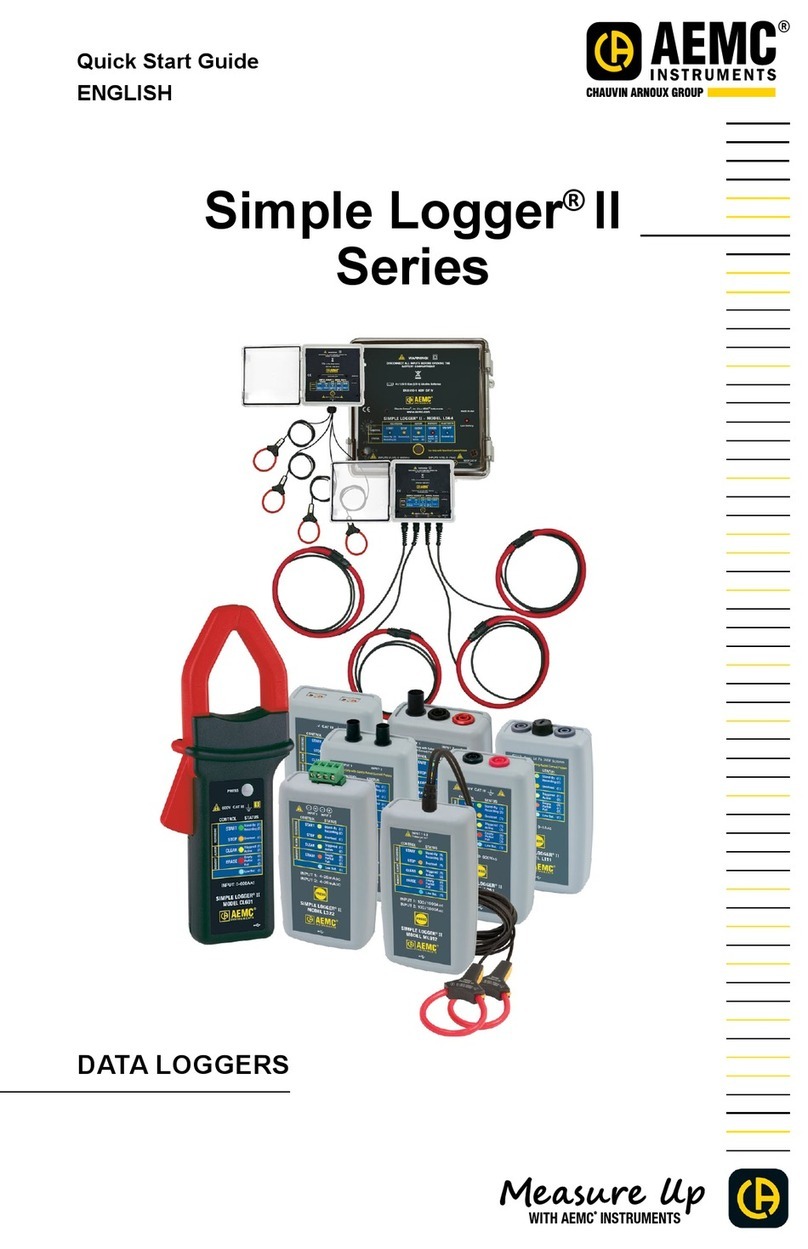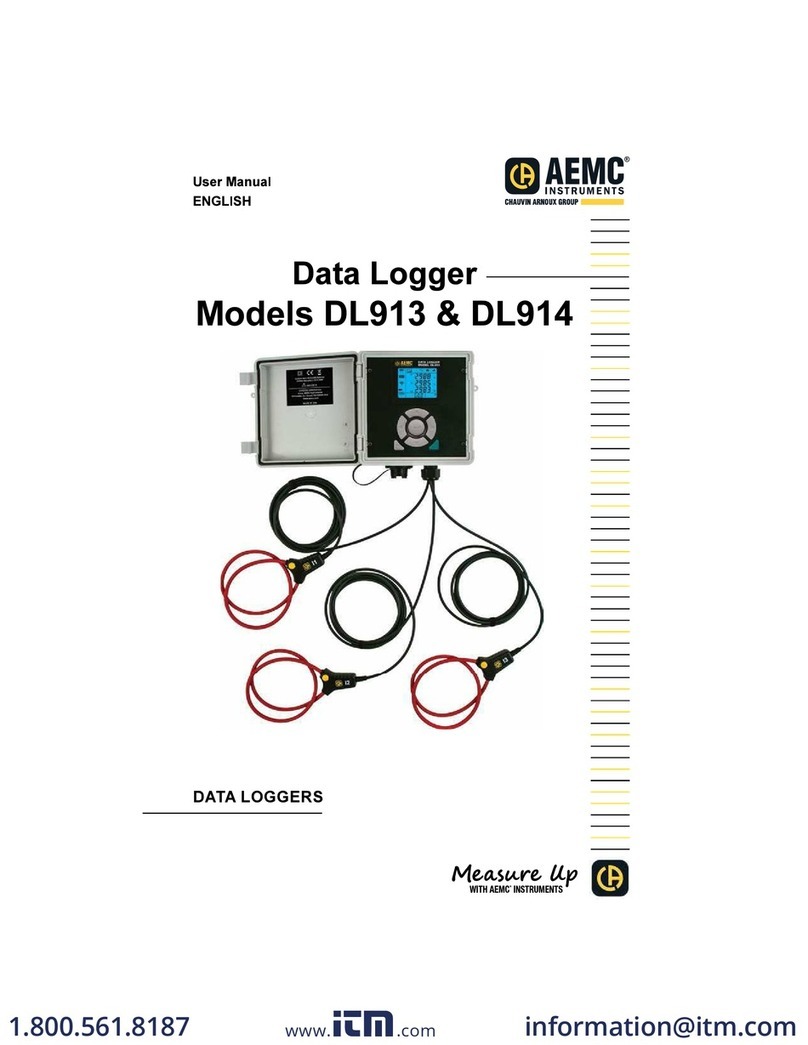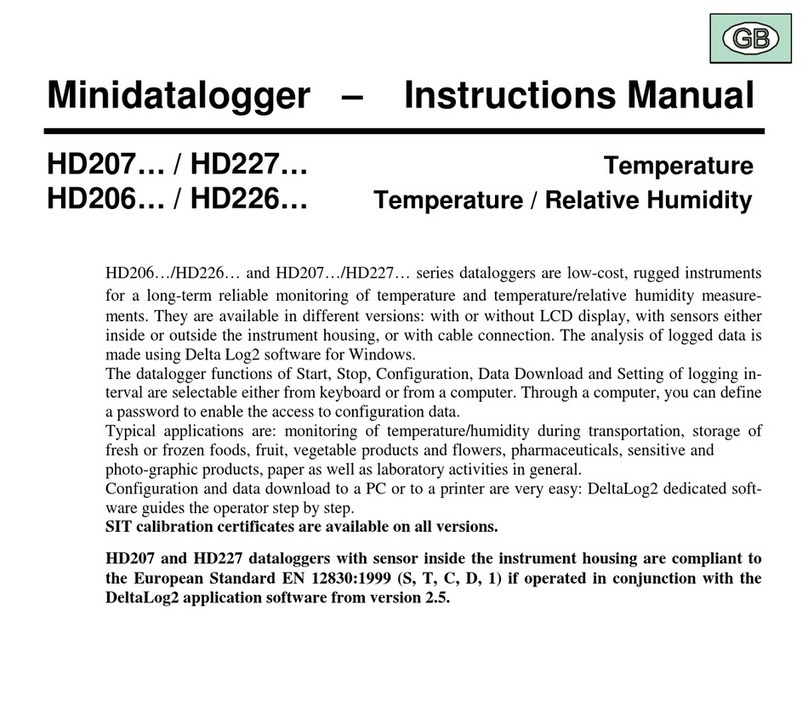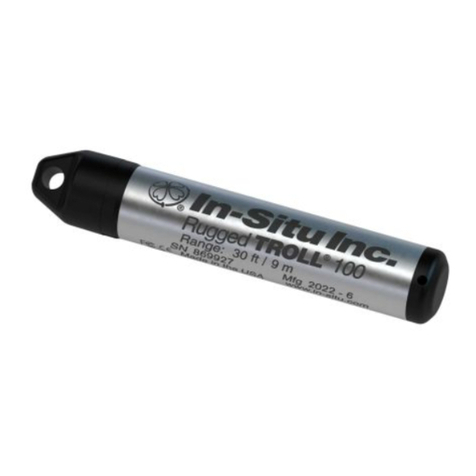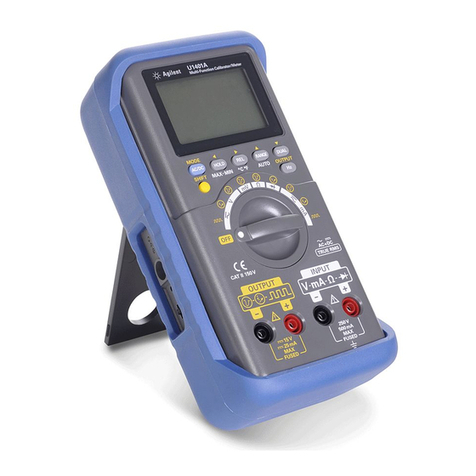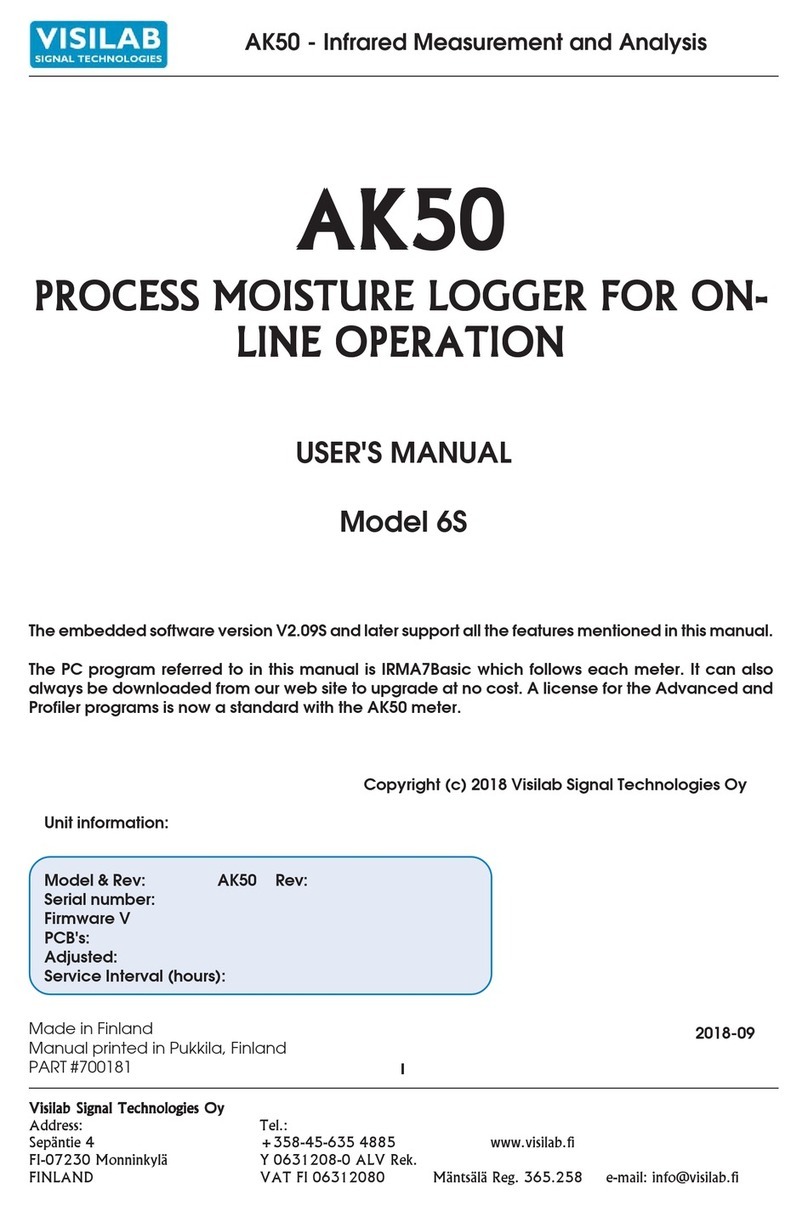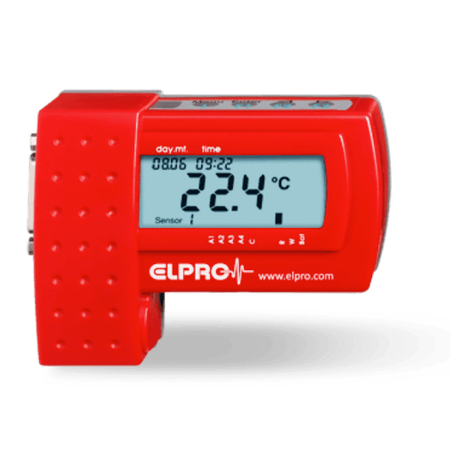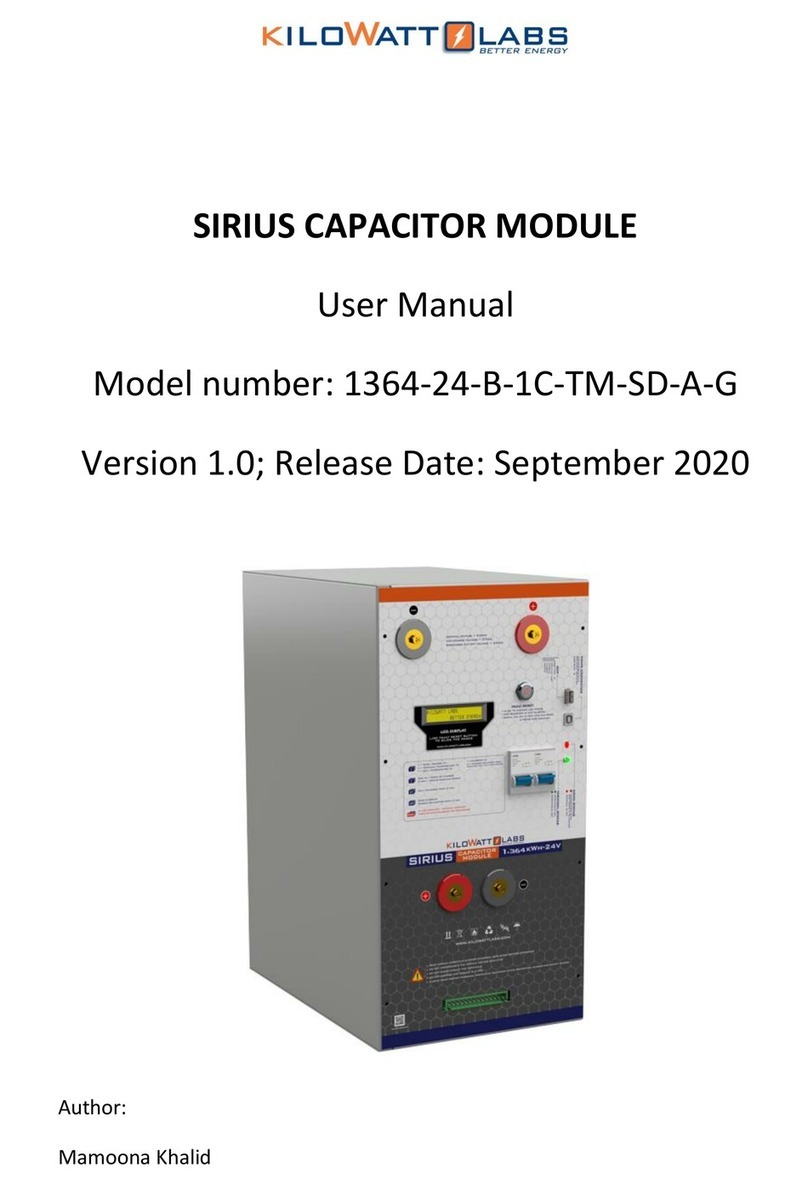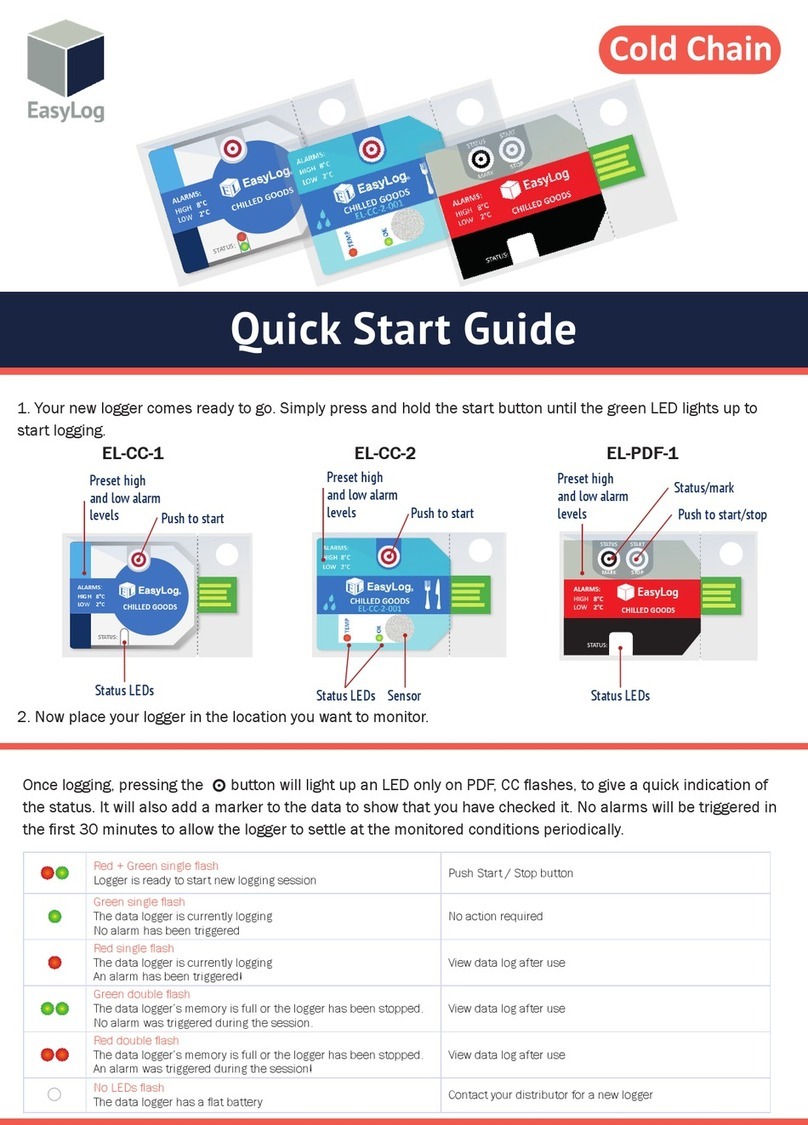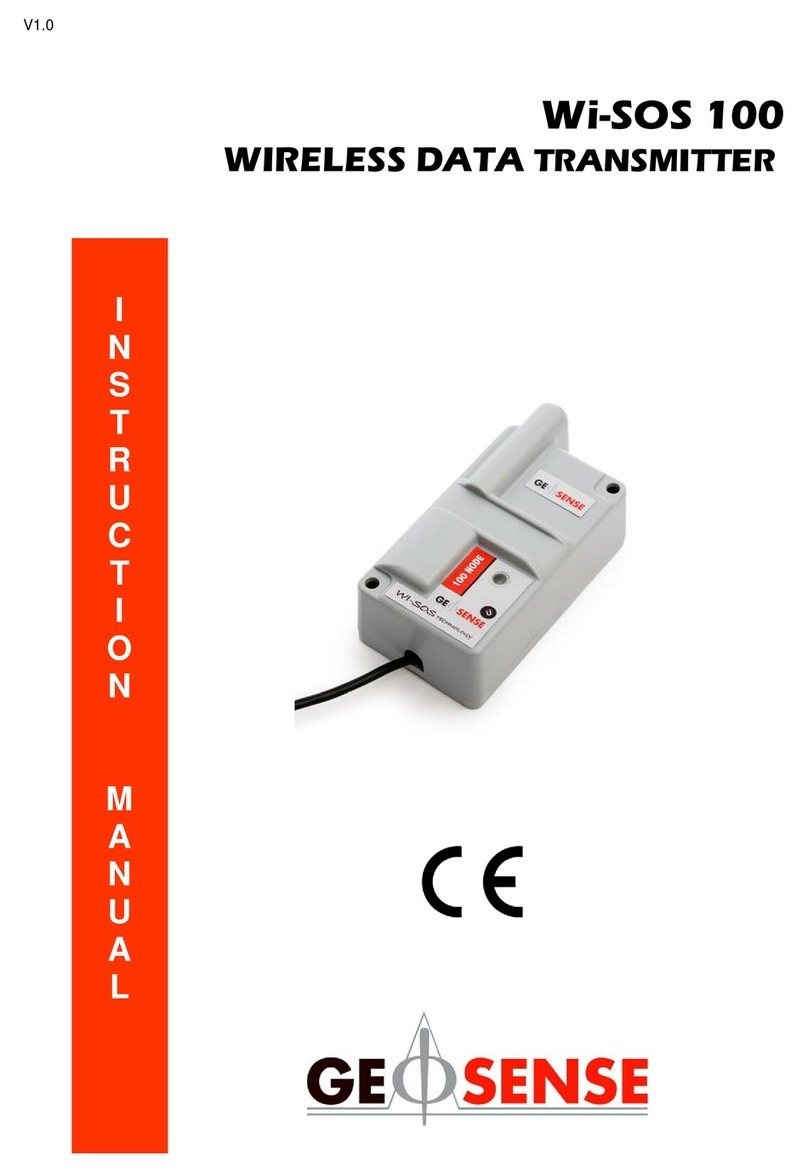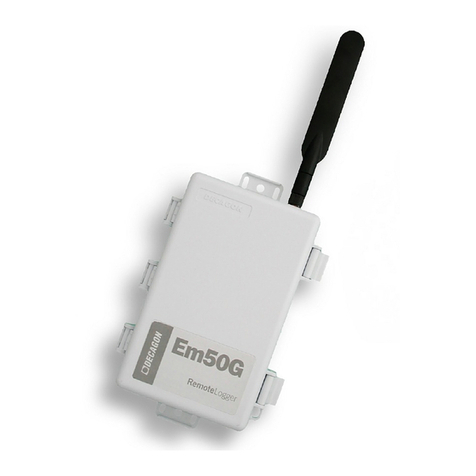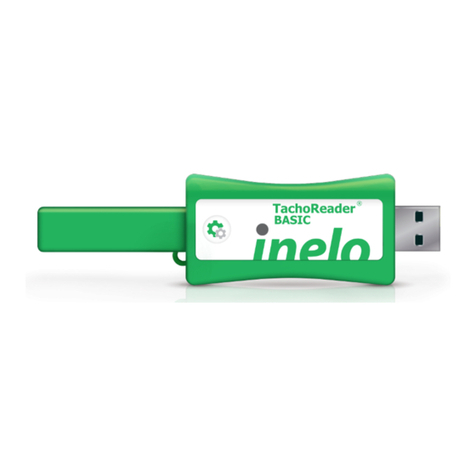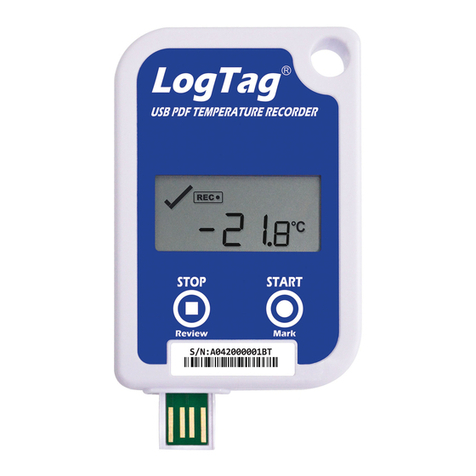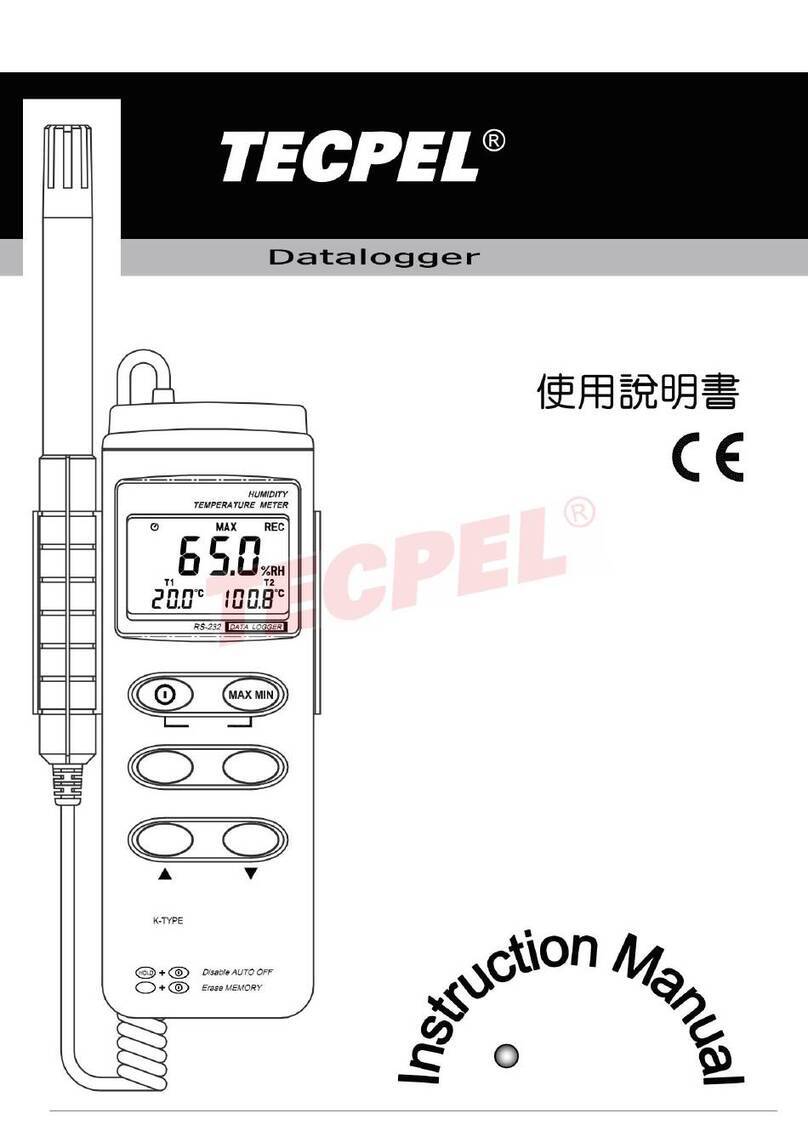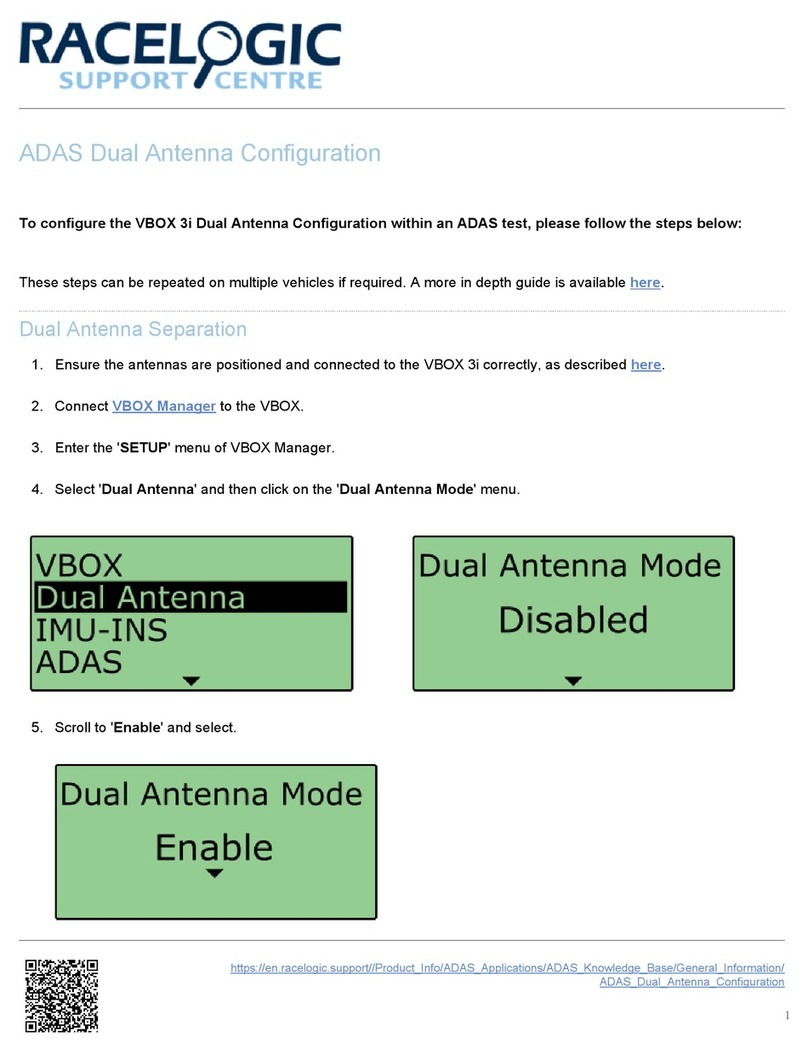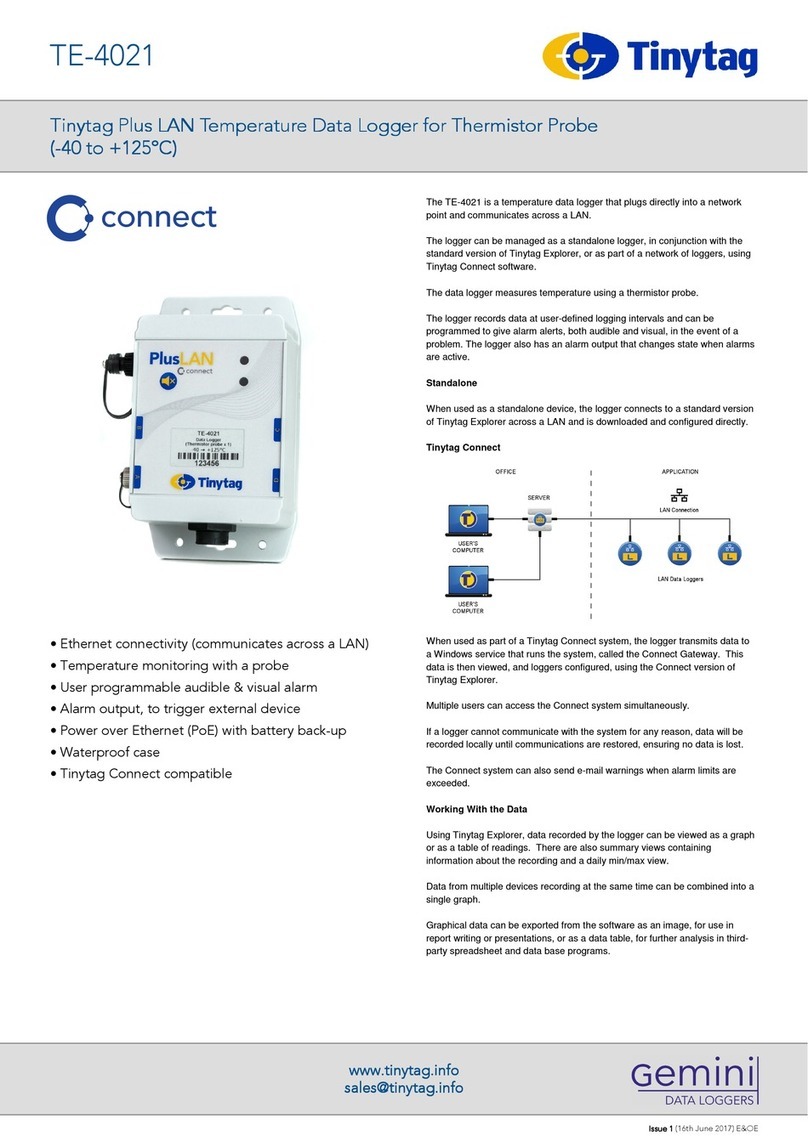AEMC instruments L452 User manual

Data Logger
Model L452
ENGLISH
Quick Start Guide
www.aemc.com

Statement of Compliance
Chauvin Arnoux®, Inc. d.b.a. AEMC® Instruments
certifies that this instrument has been calibrated using
standards and instruments traceable to international
standards.
We guarantee that at the time of shipping your
instrument has met its published specifications.
An NIST traceable certificate may be requested at
the time of purchase, or obtained by returning the
instrument to our repair and calibration facility, for
a nominal charge.
The recommended calibration interval for this
instrument is 12 months and begins on the date of
receipt by the customer. For recalibration, please
use our calibration services. Refer to our repair and
calibration section at www.aemc.com.
Serial #:
Catalog #: 2153.51
Model #: L452
Please fill in the appropriate date as indicated:
Date Received:
Date Calibration Due:
Chauvin Arnoux®, Inc.
d.b.a AEMC®Instruments
www.aemc.com

Data Logger Model L452
Cat. #2153.51
Also Included:
(1) USB Stick with User Manual & DataView® Software
US 120V Wall Plug to USB
Cat. #2153.78
Cable - 6 ft USB
Cat. #2138.66
PRODUCT PACKAGING

Thank you for purchasing a Data Logger Model L452.
For best results from your instrument and for your safety, read the enclosed operating
instructions carefully and comply with the precautions for use. These products must be
only used by qualied and trained users.
Symbols
Signies that the instrument is protected by double or reinforced
insulation.
CAUTION - Risk of Danger! Indicates a WARNING that the operator
must refer to the User Manual for instructions before operating the
instrument in all cases where this symbol is marked.
Risk of electric shock. The voltage at the parts marked with this
symbol may be dangerous.
Bluetooth enabled.
Ground/Earth.
Important instructions to read and understand completely.
Important information to acknowledge.
Battery.
Fuse.
USB socket.
Compliance with the Low Voltage & Electromagnetic Compatibility
European directives (73/23/CEE & 89/336/CEE)
In the European Union, this product is subject to a separate collection
system for recycling electrical and electronic components In
accordance with directive WEEE 2002/96/EC.
The product has been declared recyclable.
Denition of Measurement Categories (CAT)
CAT IV corresponds to measurements taken at the source of low-voltage installations.
Example: power feeders, counters, and protection devices.
CAT III corresponds to measurements taken on building installations.
Example: distribution panel, circuit-breakers, machines, or xed industrial devices.
CAT II corresponds to measurements taken on circuits directly connected to low-
voltage installations.
Example: power supply to domestic electrical appliances and portable tools.

Precautions Before Use
These warnings are provided to ensure the safety of personnel. Please read and
comply with these precautions.
This instrument complies with safety standard EN 61010-1 (Ed 3) and IEC
61010.2-030 (Ed 1) for voltages and categories of installation at an altitude below
2000m (6562ft) and indoors with a degree of pollution at most equal to 2. The
instrument operates at 30V maximum to ground ( ).
■Do not use this instrument in an explosive atmosphere or in the presence of
ammable gases.
■Observe the maximum voltages and intensities assigned between terminals
and ground/earth.
■Do not use the instrument if it appears damaged, incomplete, or improperly
closed.
■Before each use, check the condition of the insulation of cables, case, and
accessories. Anything that appears damaged (even partially) must be reported
for repair or scrapping.
■Use only leads and accessories that meet instrument specications.
■Observe the environmental specications for the use of this instrument as
specied in §7 of the User Manual.
■Do not modify the instrument. Use only original replacement parts. Repairs or
adjustments must be performed by authorized personnel.
■Replace the batteries when they can no longer hold a charge. Disconnect all
cables from the instrument before opening the access door to the batteries as
explained in §8.1.3 of the User Manual.
■Use protective equipment as required by the environment where you are
operating this instrument.
■Keep ngers behind the guard when handling probes, probe tips, current
sensors, signal conditioners, and alligator clips.

Installing Batteries
The Model L452 can operate on two power sources:
■USB cable connected to an external power source, such as a computer or wall plug
adapter.
■Two internal 1.2V AA 2400mAh NiMH rechargeable batteries.
You must insert the batteries into the instrument before use, even if you plan to run the
instrument on USB power.
1. Holding the instrument rmly, slide the back cover to the right and remove it.
2. Insert the two batteries, while ensuring the positive and negative ends are
properly aligned.
3. Replace the back cover by aligning the tabs in the cover with the corresponding
slots in the instrument body and sliding the cover to the left until it locks in place.
NOTE: If the Model L452 is stored without the batteries installed, the internal clock will
need to be reset as instructed in the following section.
Initial Setup
NOTE: Fully charge the batteries before using the instrument for best results (12hrs).
The instrument can be set up two ways:
■DataView Data Logger Control Panel.
■Model L452 Front Panel Interface.
Setup via the DataView® Data Logger Control Panel
Initial setup via the Control Panel requires three steps:
■Install DataView®and the Data Logger Control Panel on your computer.
■Connect the instrument to the computer via USB cable or Bluetooth.
■Congure the instrument’s settings in the Control Panel.
Installing DataView® and the Data Logger Control Panel
DataView® installations may dier slightly depending on your operating system. The
following instructions are based on a Windows 7 operating system.
1. Ensure that the USB cable is not connected to the computer. Then, insert the USB
thumb drive into an available USB port on your computer. If Autorun is enabled,
an AutoPlay window will appear on your screen. Click “Open folder to view les”
to display the DataView®folder. If Autorun is not enabled or allowed, use Windows
Explorer to locate and open the USB drive labeled “DataView.”
2. When the DataView folder is open, double-click the le Setup.exe in the root
directory.
3. The Setup screen will appear and enable you to select the language version of
the setup program. You can also select additional install options (each option is
explained in the Description eld). Make your selections and click Install.

4. Click OK to conrm setup. The InstallShield Wizard screen will appear. This
program leads you through the DataView install process. As you complete these
screens, be sure to check the Data Loggers option when prompted to select
features to install.
5. When the InstallShield Wizard nishes installing DataView, the Setup screen will
appear. Click Exit to close. The DataView folder will appear on your computer
desktop.
6. Open the DataView folder on your desktop. This folder contains the DataView,
Data Logger Control Panel icons, and any other installed Control Panel(s).
Connecting via USB Cable
The following steps assume that the instrument has not been previously connected to
the computer via USB cable:
1. Plug one end of the cable into the instrument and the other end into an available
USB port on the computer. Then, press and hold the button until the message
POWER ON appears on the LCD. Wait for driver installation to nish before
proceeding to the next step (a message will appear on your computer when driver
installation is complete).
2. Open the Data Logger Control Panel.
3. In the menu bar at the top of the screen, select Help. In the drop-down menu that
appears, click the option Help Topics to open the Data Logger Control Panel Help
system.
4. Use the Contents window in the Help system to locate and open the topic
“Connecting to an Instrument,” which describes how to connect the Model L452 to
the computer.
When the instrument is connected, its name will appear under the Data Logger
Network in the Control Panel’s navigation frame.
Connecting via Bluetooth
Bluetooth must be enabled and congured on the instrument before you can connect
to the computer:
1. At the “home” (Channel 1 & 2 Measurement Data) screen, press ► four times to
display the Language and Date/Time Format screen. Then, press ▼ four times to
display the Bluetooth Enabled/Visibility screen.
2. To change the Bluetooth setting, press twice and use the ▲ or ▼ button to
toggle between Enabled and Disabled. When the desired option is displayed,
press to save the selection and leave edit mode. When the Enabled option is
selected, the Bluetooth icon will appear in the icon bar.
3. To change the Visibility setting, press to initiate selection mode. Then, press
▼ to select the Visibility eld. Press to initiate edit mode and use ▲ or ▼ to
toggle between Visible and Invisible. To connect the instrument for the rst time,
this should be set to Visible. When the desired option is selected, press to
save the setting and leave edit mode.
4. To change the instrument’s Bluetooth name, press ▼ at the Bluetooth Enabled/
Visibility screen. This will display the Bluetooth Name screen.

5. To change the editable part of the name, press twice and use ▲ and ▼ to
change the selected character. Then, press ► to highlight the next character and
use the ▲ and ▼ buttons to make your change. You can also press ◄ to navigate
back to a previous character. When nished, press to save your changes.
With Bluetooth enabled and congured on the instrument, you can connect to the
computer. These steps assume the instrument has not been previously connected via
Bluetooth:
1. Open the Bluetooth Devices dialog on your computer to pair the Model L452 with
your computer. Dierent operating systems have dierent steps for opening this
dialog, so consult your computer’s documentation for instructions.
2. Once the dialog is displayed, click Add a Device. A dialog box will appear and list
the locally available Bluetooth devices.
3. Find the instrument, which will appear listed by its Bluetooth name as displayed in
the Model L452’s Bluetooth Name screen. If the name does not appear, check the
Bluetooth Enabled/Visibility screen on the Model L452 to ensure the Visibility eld
is set to Visible. Also, ensure the instrument is turned ON. If the name is visible,
click it.
4. Enter the pairing code (0000) and click Next. A screen will appear and inform you
that the instrument has been successfully connected with the computer. Click
Close to exit the screen.
5. Open the Data Logger Control Panel. In the menu bar at the top of the screen,
select Help. In the drop-down menu that appears, click the option Help Topics to
open the Data Logger Control Panel Help system.
6. Use the Contents window in the Help system to locate and open the topic
“Connecting to an Instrument.” This topic will explain how to connect the Model
L452 to the computer.
When the instrument is connected, its name will appear under Data Logger Network in
the Control Panel’s navigation frame.
Conguring the Instrument via the Control Panel
1. With the instrument connected, click its name under Data Logger Network in the
Control Panel.
2. Select Instrument in the menu bar and click Congure.
3. In the General tab of the Congure Instrument dialog box, set the instrument’s
clock, date/time format, and user interface language. Press the Help button at the
bottom of the dialog box for instructions.
Setup via the Model L452 User Interface
In addition to enabling/disabling and conguring Bluetooth, the following conguration
parameters can be set through the instrument’s front panel interface:
■Language.
■Date and time.
The “home” screen for the interface is the Channel 1 & 2 Measurement screen. You
can return to this screen at any time by giving the button a short (less than 2
seconds) press.

Choosing the Interface Language
1. At the “home” screen, press ► four times to display the Language and Date/Time
Format screen.
2. Press the Enter button twice.
3. Use the ▲ or ▼ button to cycle through the available languages: English,
Español, Italiano, Deutsch, and Français.
4. When the desired language choice is displayed, press . The text on all screens
will appear in the selected language.
Setting the Instrument Date and Time
1. With the Language and Date/Time Format screen displayed, press . This
initiates selection mode; the setting under the Language eld will change to
blinking reversed text.
2. Press ▼. The setting under Date/Time will appear in blinking reversed text.
3. Press to initiate edit mode.
4. Press ▲ or ▼ to cycle through the available options for date and time format.
5. After you make your selection, press to save it. All elds on the Language and
Date/Time Format screen should now appear in regular text.
6. Press ▼ three times. The Date and Time screen will appear.
Press once to initiate selection mode. The rst number in the Date eld will
blink. To change this number, press to initiate edit mode. Then, use the ▲ and
▼ buttons to increase/decrease this number until the correct value is displayed.
To change the other two settings in the Date eld, press ► to navigate to the
number you want to set. Then, press ▲ or ▼ to change the setting. You can also
use ◄ to navigate back to a previous number.
7. To change the Time eld, press ► while the last number in the Date eld is
selected. This highlights the rst number in the Time eld.
Alternatively, if you are not in edit mode (for example, you have opened the
Date and Time screen and only want to change the time while leaving the date
unchanged), press to initiate selection mode. Then, while the rst number in
the Date eld is blinking, press ▼. The rst number in the Time eld will blink;
press to initiate edit mode.
8. Change the numbers in the Time eld using the buttons as explained in the steps
above.
9. When you have nished setting the Date and Time values, press to save your
changes and leave edit mode.

Channel Conguration
Channels can be congured either through the Data Logger Control Panel or the
instrument interface:
■Consult the Data Logger Control Panel Help system for information about
conguration through the Control Panel.
■Consult “L452 User Interface Screens” later in this Quick Start Guide for a table
with all available conguration screens through the user interface. For detailed
instructions about how to complete these screens, see the Model L452 User
Manual.
When conguring through the instrument’s interface, each of the instrument’s two
channels has its own set of conguration screens; the screens for one channel are
essentially identical to the screens for the other. These screens allow you to:
■Enable and disable the channel. When disabled, measurements are neither
recorded nor displayed for the channel.
■Select the type of input. This can be analog (voltage or current), pulse, or event.
Both channels must have the same input type.
■Dene measurement units to use when displaying measurement data.
■Dene scaling to establish the relationship between input and measurement units.
■Enable and dene alarm triggers to determine if the instrument will report an alarm
condition and the circumstances that will trigger an alarm condition.
Channels must be congured before you start a recording session.
Recording Data
Recording sessions can be congured and scheduled via the Data Logger Control
Panel, as explained in the Help. The instrument’s user interface also includes a set of
screens for controlling and conguring a recording session. These screens enable you
to:
■Specify the sample and storage periods to be used during the recording session.
■Start a recording session immediately.
■Schedule a recording for a future time.
■Set a length of time for the recording to run.
■Schedule start/stop dates and times for the recording.
■Stop an in-progress recording.
■Cancel a scheduled recording.
The Recording and Duration screen is the starting point for working with recordings.
This is the top-level screen for all recording-related activities. To see this screen,
display the “home” (Channel 1 & 2 Measurement Data) screen and press ►.
Consult the Model L452 User Manual for detailed information about conguring
recording sessions.

Starting a Recording Session
You can start a congured recording session immediately or schedule one for a later
date and time. To start a recording immediately:
1. At the “home” screen, press ► to display the Recording and Duration screen.
The Duration eld on this screen species the length of the recording session. By
default (assuming no session has been already scheduled), this is 15 minutes.
The Duration setting cannot be shorter than the Storage Period setting.
2. To change the duration setting, press to initiate selection mode and press ▼ to
select the Duration eld. Then, press to start edit mode and use the buttons to
enter a duration period.
For example, to change the duration from 15 minutes to 3 days, select the “1” in
“15 min” and press to begin edit mode. Use ▼ to change this to a zero. Then,
press ► to highlight the number “5.” Press ▼ twice to change this to “3.” Finally,
press ► to select the units and use the ▲ and ▼ buttons to cycle through the
available choices. These include s (seconds), min, hours, days, and weeks. Select
“days” and press to save your change. Alternatively, instead of the Duration
eld you can use the Stop Date and Stop Time screen to determine how long the
recording session will run.
3. To start the recording, press three times. The recording session will start
immediately using your specied conguration settings. The recording session will
end when the time interval dened by the Duration eld ends.
When a recording is active, the Recording icon will appear as a solid circle in the
icon bar at the top of the scree. If you attempt to turn OFF the instrument by pressing
while a recording is in progress, the message RECORDING ACTIVE will appear on
the screen. The button is disabled while a recording is in progress.
Scheduling a Recording Session
Instead of starting a recording immediately, you can schedule a recording for a future
date and time. You can only schedule one recording at a time. To schedule a new
recording, the active recording must run to completion, or you must cancel the earlier
recording.
1. At the “home” screen, press ► to display the Recording and Duration screen.
2. Press ▼ twice to display the Start Date/Time screen.
3. Press twice. The rst number under Start Date will be highlighted. Use the ▲
and ▼ buttons to increase or decrease the number and the ► and ◄ buttons to
move from one eld to the next. If you press ► when the last number in the Start
Date eld is selected, the selection will move to the rst number in the Start Time
eld. This will enable you to edit both the date and time in a single editing session.
When you have nished entering the start date and time, press to save your
changes.

4. You have two options for dening when the recording session will end. You can
dene when the recording session will end by either setting the Duration eld in
the Recording and Duration screen or through the Stop Date/Time screen.
To set the Duration eld, press ▲ twice to return to the Recording and Duration
screen. Then, complete the Duration eld.
To set the time and date for the end of the recording, press ▼ at the Start Date/
Time screen to display the Stop Date/Time screen.
5. By default, the settings on this screen reect the Duration setting. For example,
if the Duration eld is set to 24 hours, the stop date and time will be set to 24
hours after the start date and time. To change this, press twice. Then, use the
buttons to select and change settings, which is similar to setting the start date and
time elds as described in step 3 above.
6. When you have nished entering the stop date and time, press to save your
changes. The Duration eld in the Recording and Duration screen will be updated
to reect the duration dened by your start date/time and stop date/time.
7. If it is not already displayed, navigate to the Recording and Duration screen. Press
twice. Then, use the ▲ and ▼ buttons to toggle through the options. When
Schedule appears, press to select it.
When a recording is scheduled, the Recording icon will appear as an empty circle
in the icon bar at the top of the screen. You can turn OFF the Model L452 with a
scheduled recording pending. When the start date and time occurs, the instrument will
turn itself back ON for the duration of the recording and automatically turn OFF once
the recording is complete.
Stopping or Cancelling a Recording Session
As noted previously, you cannot start or schedule a recording session if a recording is
active or another scheduled recording is pending. In either case, you will need to stop
or cancel the recording before you can start or schedule another.
To stop an active recording or cancel a scheduled one, display the Recording and
Duration screen.
■If a recording is active, the only option available on this screen will be Stop.
■If a recording is scheduled, the only option available on this screen will be Cancel.
In either case, press the button three times to immediately stop or cancel the
recording, depending on the selection. The Recording icon will disappear, which
indicates that no recording is currently active or scheduled. In addition, the remaining
recording-related screens will become active and enable you to start or schedule a
new recording.

L452 User Interface Screens
The primary interface for working with the Model L452 consists of conguration and
display screens. These screens appear in the instrument’s front-panel LCD. You can
use the instrument’s buttons to navigate these screens, select options, and enter
information.
Screens are grouped into six categories:
■Measurement Data screens display data currently being measured on Channel 1
and/or Channel 2.
■Recording screens congure, start, schedule, stop, and cancel a recording
session.
■Channel 1 Conguration screens enable/disable Channel 1, determine what data
is recorded by the channel, and how the data is displayed.
■Channel 2 Conguration screens are identical to Channel 1 Conguration
screens, except they apply to the instrument’s Channel 2.
■Instrument Conguration screens congure general instrument settings.
■Instrument Information screens display read-only settings on the instrument.
Each category has a “top level” screen that is the rst screen that appears when you
move to the category. The following table displays how the categories and screens are
organized.

Measurement
Data
Recording Channel 1
Conguration
Channel 2
Conguration
Instrument
Conguration
Instrument
Information
Channels
1 & 2
Measurement
Data
(“Home”
screen)
Start/Stop/
Schedule/
Cancel a
Recording,
and Set
Duration
Enabled/
Disabled and
Input Type
Enabled/
Disabled and
Input Type
Language and
Date/Time
Format
Model
Number, Serial
Number, and
Firmware
Revision
Channel 1
Measurement
and Min/Max
Data
Sample
Period and
Storage
Period
*Units *Units Memory Erase
and Min/Max
Reset
Instrument
Name and
Location
Channel 2
Measurement
and Min/Max
Data
Start Date
and Time
**Low Scaling **Low Scaling Conguration
Reset
Recording
Sessions
Stop Date
and Time
**High Scaling **High Scaling Date and Time Recording
Name
**Alarm Trigger **Alarm Trigger Bluetooth
Enable/Disable
and Visibility
**Upper Limit
and Lower
Limit
**Upper Limit
and Lower Limit
Bluetooth Name
Equivalence
(Pulse Input
Only)
Equivalence
(Pulse Input
Only)
Trigger (Event
Input Only)
Trigger (Event
Input Only)
*Not displayed when input is set to Event.
**Not displayed when input is set to Event or Pulse.
Pressing the ► or ◄ button while in navigation mode will move from one category of
screens to the next. These buttons work from any screen in a category. For example,
pressing ► from any of the three Measurement Data screens displays the top-level
Recording screen. The categories are cyclical, so pressing ► at an Instrument
Information screen moves to the top-level screen in Measurement Data, while pressing
◄ in a Measurement Data screen displays the top-level Instrument Information screen.
The ▲ and ▼ buttons let you navigate the screens within each category. These are
also cyclical; pressing ▲ in a category’s top-level screen displays the bottom level
screen in that category, while pressing ▼ at the bottom-level screen displays the
category’s top-level screen.

Repair and Calibration
To ensure that your instrument meets factory specications, we recommend that it be
scheduled back to our factory Service Center at one-year intervals for recalibration or
as required by other standards or internal procedures.
For instrument repair and calibration:
You must contact our Service Center for a Customer Service Authorization Number
(CSA#). This will ensure that when your instrument arrives, it will be tracked and
processed promptly. Please write the CSA# on the outside of the shipping container. If
the instrument is returned for calibration, please specify whether you want a standard
calibration, or a calibration traceable to N.I.S.T. (includes calibration certicate plus
recorded calibration data).
Ship To: Chauvin Arnoux®, Inc. d.b.a. AEMC®Instruments
15 Faraday Drive
Dover, NH 03820 USA
Phone: (800) 945-2362 (Ext. 360)
(603) 749-6434 (Ext. 360)
Fax: (603) 742-2346 or (603) 749-6309
(Or contact your authorized distributor)
Costs for repair, standard calibration, and calibration traceable to N.I.S.T. are available.
NOTE: You must obtain a CSA# before returning any instrument.
Technical and Sales Assistance
If you are experiencing any technical problems, or require any assistance with the
proper operation or application of your instrument, please call, mail, fax or e-mail our
technical support team:
Chauvin Arnoux®, Inc. d.b.a. AEMC®Instruments
15 Faraday Drive
Dover, NH 03820 USA
Phone: (800) 343-1391 (Ext. 351)
Fax: (603) 742-2346
www.aemc.com

03/22
99-MAN 100423 v6
Chauvin Arnoux®, Inc. d.b.a. AEMC®Instruments
15 Faraday Drive • Dover, NH 03820 USA • Phone: (603) 749-6434 • Fax: (603) 742-2346
www.aemc.com
Table of contents
Other AEMC instruments Data Logger manuals
